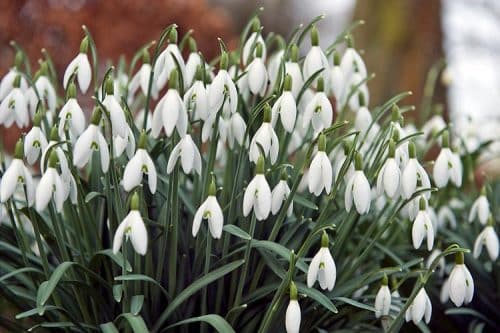Snowdrops (Galanthus nivalis)
Snowdrops derive their name for two readily apparent reasons. First is their lovely milky white color that resembles snowy dew at the end of pale green stalks (Galanthus means “milky white flower”). The second is their bloom schedule. Snowdrops are almost always the first plants to flower in the spring, in some cases literally poking their heads up in between the last melting snows of March.

Snowdrops
Snowdrops are spread throughout the Conservatory Garden and can be found in almost all the flowering beds. The major benefit of planting Snowdrops is their early arrival. They can show up weeks before crocuses do, and will often poke through a covering of snow. In the South, snowdrops may even bloom all winter long.
The facts – all species of Galanthus have bulbs, linear leaves, and erect flowering stalks, destitute of leaves but bearing at the top a solitary pendulous bell-shaped flower. Galanthus nivalis grows 15 cm tall, flowering in January or February in the northern temperate zone. The white flower has six petals, the outer three segments being larger and more convex than the inner series. The six anthers open by pores or short slits. The ovary is three-celled, ripening into a three-celled capsule.
It has been suggested that the mysterious magical herb moly that appears in Homer’s Odyssey is actually snowdrop. An active substance in snowdrop is called galantamine, which, as anticholinesterase, could have acted as an antidote to Circe’s poisons. Please let us know if anyone is able to drop that tidbit into cocktail party conversation.
Classical references aside the Snowdrop may simply be known best as the first sign that winter is almost over and spring is not only theoretical, but an imminent reality.
 Conservatory Garden
Conservatory Garden
One of the hidden wonders of Central Park is the Conservatory Garden at Fifth Avenue and 105th St. A secluded oasis, just a few steps down from one of the City’s busiest thoroughfares; the garden offers a fragrant respite from the gasp and clatter of the urban afternoon.


